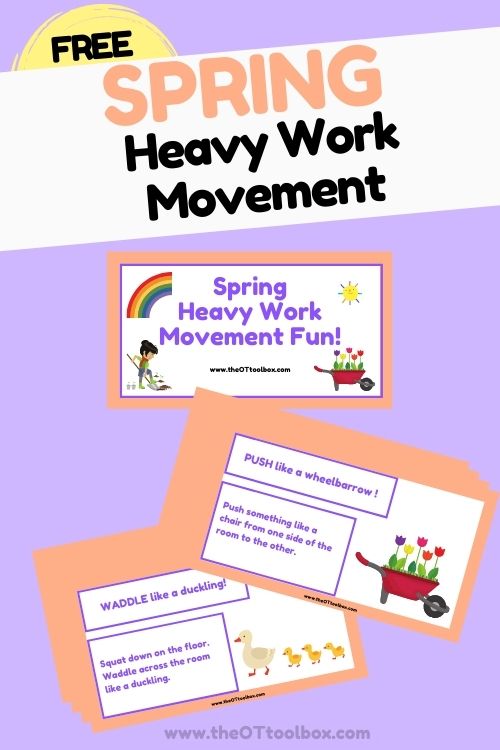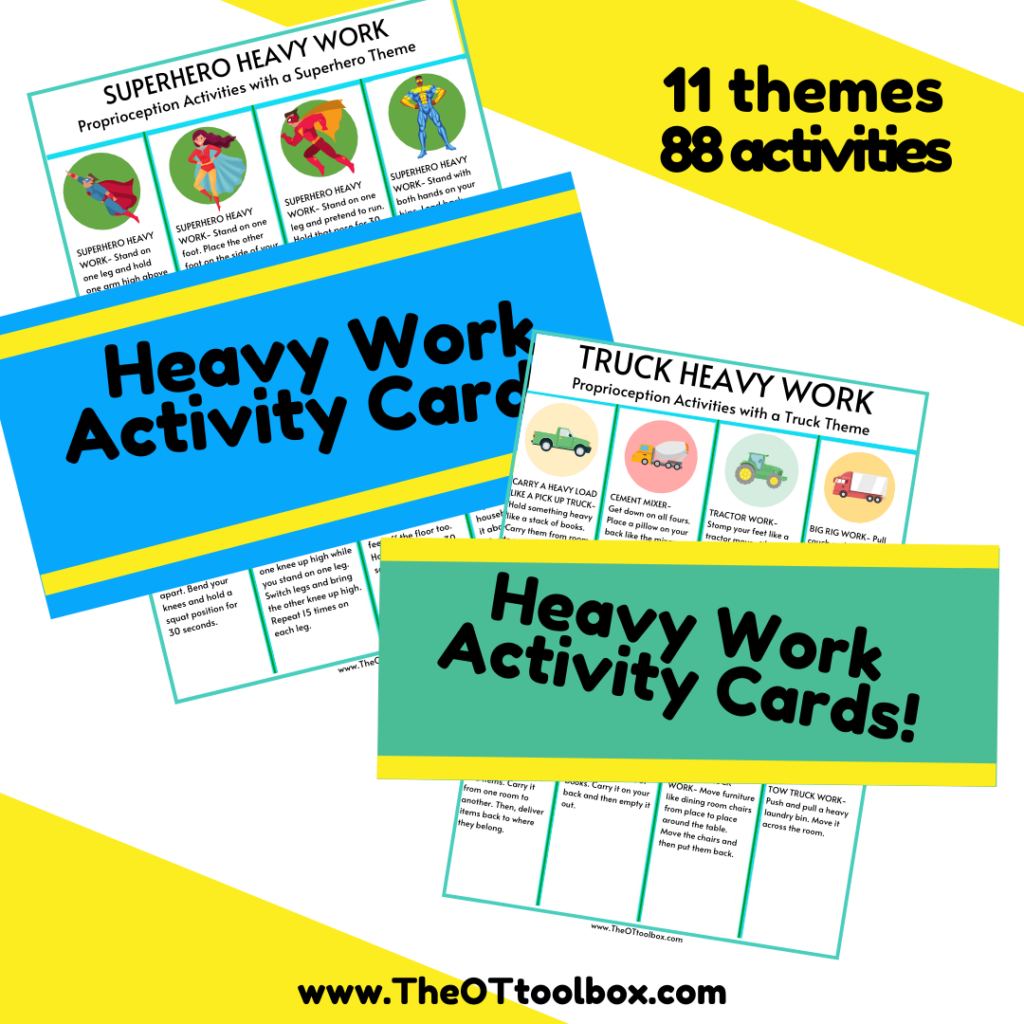Offering sensory, heavy work in teletherapy doesn’t need to be difficult. Wondering how to support sensory kids virtually? Need ideas to help with attention or focus in the classroom? This free teletherapy slide deck covers an area that is much needed for many children. We know that kids today need to move more. But did you know the part that heavy work plays into development and self-regulation strategies in kids?

We see it all the time: kids in teletherapy or in the virtual classroom that just can’t sit still or pay attention. And there’s a lot going on when screens are involved. The research on screen time is telling. But other times, kids are just being kids and movement is needed! Brain breaks and movement breaks are as necessary as hydration and eating healthy meals when it comes to learning.
What is Heavy Work?
Heavy work is a sensory strategy that helps children regulate so they are at a calm-ready state of learning and participation in tasks. For kids, heavy work helps them know where their body is in space by using the proprioceptive sensory system.
When deep heavy input is offered, the child challenges their proprioceptive system. Input in the child’s muscles and joints lets their brain know about body position, weight, pressure, stretch, movement and changes in position in space. Then, the body is able to grade and coordinate movements based on the way muscles move, stretch, and contract. In this way, the proprioceptive system allows us to apply more or less pressure and force in a task.
Proprioception and that heavy work input occurs when we lift, jump, pull, carry, hug, snuggle, crash, climb, push, etc. All of these movements incorporate the muscles and joints and offer “heavy work” input.
Kids who may benefit from heavy work input might do some of these things:
- Appear clumsy
- Fidget when asked to sit quietly.
- Show an increased activity level or arousal level.
- Seek intense proprioceptive input by “crashing and bashing” into anything.
- Slap their feet when walking.
- Flap hands.
- Use too much or too little force on pencils, scissors, objects, and people.
- “No fear” when jumping or walking down stairs.
- Or, are overly fearful of walking down steps/jumping.
- Look at their body parts (hands/feet) when completing simple tasks.
- Sit down too hard or miss chairs when sitting.
- Fall out of their seat.
- Fluctuates between over-reacting and under-reacting in response to stimulation.
- Constantly on the move.
Heavy work is a huge part of sensory diets that are created to help kids organize their sensory systems and regulate those sensory needs.
Occupational therapists recommend heavy work to calm and help kids pay attention. And, if there were any time that heavy work was more needed, it might be during virtual learning.
For more heavy work ideas that cover a variety of themes, grab a copy of the Heavy Work Movement cards.

Heavy Work Teletherapy Activity
So how do you incorporate heavy work and all the benefits of proprioceptive sensory input into a teletherapy or virtual learning environment?
That’s where this heavy work virtual therapy slide deck comes into play. I created this slide deck as part of our free slides here on the site, as a support for therapists working with kids in virtual environments. We know that kids need movement to support learning and development of motor skills. They need to move and get that heavy work feedback so they can pay attention, focus, and learn.
This heavy work activity does just that.
Therapists (or teachers, or parents) can use this heavy work activity to help kids get the deep resistive input that they need.
Kids can go through the slide deck and complete each activity. The slides use Spring images and concepts to incorporate proprioception and to offer FUN ways to add heavy work and help kids calm or regulate their sensory needs.

Spring heavy work activities in the slide include:
- Digging in dirt
- Pushing a wheelbarrow
- Crawling like a bear coming out of hibernation (Pair the activity with others from our collection of hibernation activities!)
- Waddling like a duckling
- MORE!
Users can act out each heavy work activity on the slides and work on motor planning, coordination, bilateral coordination, gross motor skills, AND gain the benefits of heavy work input!
Free heavy work slide deck
Want this slide deck in your therapy toolbox? Enter your email address into the form below to access this free slide on your Google drive.

Colleen Beck, OTR/L has been an occupational therapist since 2000, working in school-based, hand therapy, outpatient peds, EI, and SNF. Colleen created The OT Toolbox to inspire therapists, teachers, and parents with easy and fun tools to help children thrive. Read her story about going from an OT making $3/hour (after paying for kids’ childcare) to a full-time OT resource creator for millions of readers. Want to collaborate? Send an email to contact@theottoolbox.com.







